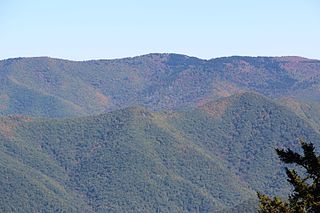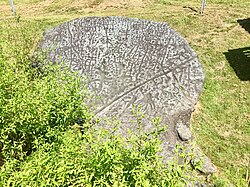
Jackson County is a county located in the western part of the U.S. state of North Carolina. As of the 2020 census, the population was 43,109. Since 1913, its county seat has been Sylva, which replaced Webster.

Cullowhee is a census-designated place (CDP) in Jackson County, North Carolina, United States. It is located on the Tuckasegee River, and the permanent population was 7,682 at the 2020 census up from 6,228 at the 2010 census.

A petroglyph is an image created by removing part of a rock surface by incising, picking, carving, or abrading, as a form of rock art. Outside North America, scholars often use terms such as "carving", "engraving", or other descriptions of the technique to refer to such images. Petroglyphs, estimated to be 20,000 years old are classified as protected monuments and have been added to the tentative list of UNESCO's World Heritage Sites. Petroglyphs are found worldwide, and are often associated with prehistoric peoples. The word comes from the Greek prefix petro-, from πέτρα petra meaning "stone", and γλύφω glýphō meaning "carve", and was originally coined in French as pétroglyphe.
Tsul 'Kalu, also known as the Cherokee Devil, is a legendary figure of Cherokee mythology that plays the role of "the great lord of the game," and as such is frequently invoked in hunting rites and rituals.

The Tuckasegee River flows entirely within western North Carolina. It begins its course in Jackson County above Cullowhee at the confluence of Panthertown and Greenland creeks.

Nikwasi comes from the Cherokee word for "star", Noquisi (No-kwee-shee), and is the site of the Cherokee town which is first found in colonial records in the early 18th century, but is much older. The town covered about 100 acres (40 ha) on the floodplain of the Little Tennessee River. Franklin, North Carolina, was later developed by European Americans around this site.

North Carolina Highway 107 (NC 107) is a primary state highway in the U.S. state of North Carolina. The highway runs north–south from the South Carolina state line, near Cashiers, to US 23 Business in Sylva.

Track Rock is located in the Track Rock Gap Archaeological Area (9Un367) in the Brasstown Ranger District of the Chattahoochee National Forest in Georgia. This 52-acre (210,000 m2) area contains preserved petroglyphs of ancient Native American origin that resemble animal and bird tracks, crosses, circles and human footprints.
The Battle of Taliwa was fought in Ball Ground, Georgia, in 1755. The battle was part of a larger campaign of the Cherokee against the Muscogee Creek people, where a contingent of 500 Cherokee warriors led by war chief Oconostota defeated the Muscogee Creek people and pushed them south from their northern Georgia homelands, allowing the Cherokee to begin settling in the region.

Shining Rock is a mountain in western North Carolina. The mountain is one of the Great Balsam Mountains which are a part of the Blue Ridge Mountains within the Appalachian Mountains. It is the 38th tallest mountain in the eastern United States.
Oxidizable carbon ratio dating is a method of dating in archaeology and earth science that can be used to derive or estimate the age of soil and sediment samples up to 35,000 years old. The method is experimental, and it is not as widely used in archaeology as other chronometric methods such as radiocarbon dating.
Tuckasegee, named after the historic Cherokee town of that name located near here, is an unincorporated community in Jackson County, North Carolina, United States. It followed the earlier Cherokee town as developing on the upper Tuckaseegee River, at the confluence of its East and West forks.
Jackson County Public Schools is a public school district serving Jackson County, North Carolina, US. It is headquartered in the county seat of Sylva. The Jackson County School system is unique in the way that is still has a K–8 system with combined elementary and middle schools, with one central high school and one combined K–12 elementary/middle/high school. The county school system has eight schools, all with different histories and stories behind why they are the way they are today. The school system includes four kindergarten-through-8th-grade schools, two kindergarten-through-12th-grade schools, one traditional 9th-through-12th-grade high school, and one alternative 9th-through-12th-grade high school early college.
The Kenimer site (9Wh68) is an archaeological site near Sautee Nacoochee, Georgia in White County. The site contains two earthwork mounds located on top of a natural hilltop.
Archeological Site 38CK1, also known as the Upton Site, is a historic archaeological site located near Gaffney, Cherokee County, South Carolina. The site contains well preserved examples of a specialized soapstone procurement site occupied primarily during the prehistoric, Late Archaic Period. The site is divided into two major areas and the quarry exhibits both historic and prehistoric utilization.
Archeological Site 38CK44, also known as Locus 1, is a historic archaeological site located near Gaffney, Cherokee County, South Carolina. The site contains well preserved examples of a specialized soapstone procurement site occupied primarily during the prehistoric, Late Archaic Period.
Archeological Site 38CK45, also known as Locus 2, is a historic archaeological site located near Gaffney, Cherokee County, South Carolina. The site contains well preserved examples of a specialized soapstone procurement site occupied primarily during the prehistoric, Late Archaic Period.

Too-Cowee, was an important historic Cherokee town located near the Little Tennessee River north of present-day Franklin, North Carolina. It also had a prehistoric platform mound and earlier village built by ancestral peoples. As their expression of public architecture, the Cherokee built a townhouse on top of the mound. It was the place for their community gatherings in their highly decentralized society. The name translates to "pig fat" in English. British traders and colonists referred to Cowee as one of the Cherokee Middle Towns along this river; they defined geographic groupings based in relation to their coastal settlements, such as Charlestown, South Carolina.
Pacolet Soapstone Quarries encompasses 13 historic archaeological sites located near Pacolet, Spartanburg County, South Carolina. It was the site of soapstone procurement activities during the Late Archaic Period for the purpose of creating vessels. The quarry sites are characterized by large outcropping boulders of soapstone surrounded by depressions and concentrations of soapstone debris.
Nununyi was a historic village of the Cherokee people in western North Carolina, located on the eastern side of the Oconaluftee River. Today it is within the boundaries of the present-day city of Cherokee in Swain County. It was classified by English traders and colonists as among the "Out Towns" of the Cherokee in this area east of the Appalachian Mountains.













